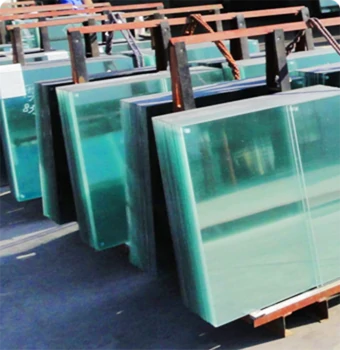The Float Glass Factory A Window into the Future
Float glass, a remarkable material that has transformed the architectural landscape, is produced through a fascinating process that balances science, precision, and craftsmanship. Float glass factories represent a critical facet of modern manufacturing, where innovation meets sustainability, delivering products that not only enhance aesthetic appeal but also improve energy efficiency in buildings.
The Float Glass Manufacturing Process
The production of float glass begins with raw materials such as silica sand, soda ash, and limestone. These ingredients are carefully selected for their purity and quality because any contamination can affect the final product's clarity and strength. Once the materials are prepared, they are mixed and heated in a furnace at temperatures exceeding 1600 degrees Celsius. This intense heat causes the mixture to melt into a molten glass.
The molten glass is then poured onto a bed of molten tin. This is the essence of the float glass process the glass naturally spreads out over the tin due to its lower density and subsequently forms a smooth, flat surface. The setup allows for the production of large sheets of glass that are uniform in thickness and free from wavy distortions. This method, invented in the 1950s, revolutionized the glass industry and allowed for the mass production of high-quality glass for windows and displays.
As the glass moves through the cooling process, it is carefully monitored to ensure that it solidifies evenly. This stage is crucial because any imperfections can lead to significant issues in subsequent applications. Once cooled, the glass is cut into desired sizes and shapes, ready for further processing or distribution.
Innovations and Sustainability
Float glass factories are at the forefront of technological innovations that strive to reduce energy consumption and minimize waste. Many modern facilities utilize state-of-the-art technology to optimize the melting process, employing regenerative burners that recycle heat, thereby increasing energy efficiency. Some factories integrate renewable energy sources, such as solar or wind power, to reduce the carbon footprint associated with glass production.
Another significant trend in float glass manufacturing is the rise of specialized coatings that enhance the glass's performance. Low-emissivity (low-e) coatings, for example, improve thermal insulation, reflecting heat back into a building during winter and keeping it cool in summer. This innovation not only contributes to energy savings but also aids in reducing greenhouse gas emissions, aligning with global sustainability goals.
float glass factory
The Role of Float Glass in Architecture
The impact of float glass extends far beyond its manufacturing process; it plays an essential role in contemporary architecture. Large glass facades have become a hallmark of modern design, allowing for natural light to flood indoor spaces while offering glimpses of the outside world. This seamless integration of indoor and outdoor environments fosters well-being and enhances the aesthetic value of buildings.
Moreover, float glass is used in various applications, from commercial skyscrapers to residential homes, and even in automotive industries. Its versatility is unmatched, available in various thicknesses and finishes, enabling architects and designers to push the boundaries of creativity. As cities evolve and the emphasis on sustainable design grows, float glass will remain central to innovative building practices.
Challenges and Future Directions
Despite the many advancements in float glass manufacturing, challenges remain. The production process is still energy-intensive, and the demand for raw materials, especially silica, raises concerns about environmental impact and resource depletion. Looking ahead, the industry must explore alternative materials and recycling processes to create a more circular economy.
Furthermore, as digitalization transforms industries, float glass factories will likely adopt smart manufacturing techniques, incorporating automation and data analytics to enhance efficiency and quality control. The future promises even more significant advancements, as manufacturers strive to create glass products that meet the evolving needs of society while prioritizing sustainability.
Conclusion
In conclusion, float glass factories not only serve as vital production hubs for this essential material but also exemplify the marriage of technology, sustainability, and design. With ongoing innovations and a commitment to eco-friendly practices, the float glass industry is poised to shape the living and working spaces of the future, proving that clear glass can indeed reflect a clearer vision for our environment.
 Afrikaans
Afrikaans  Albanian
Albanian  Amharic
Amharic  Arabic
Arabic  Armenian
Armenian  Azerbaijani
Azerbaijani  Basque
Basque  Belarusian
Belarusian  Bengali
Bengali  Bosnian
Bosnian  Bulgarian
Bulgarian  Catalan
Catalan  Cebuano
Cebuano  Corsican
Corsican  Croatian
Croatian  Czech
Czech  Danish
Danish  Dutch
Dutch  English
English  Esperanto
Esperanto  Estonian
Estonian  Finnish
Finnish  French
French  Frisian
Frisian  Galician
Galician  Georgian
Georgian  German
German  Greek
Greek  Gujarati
Gujarati  Haitian Creole
Haitian Creole  hausa
hausa  hawaiian
hawaiian  Hebrew
Hebrew  Hindi
Hindi  Miao
Miao  Hungarian
Hungarian  Icelandic
Icelandic  igbo
igbo  Indonesian
Indonesian  irish
irish  Italian
Italian  Japanese
Japanese  Javanese
Javanese  Kannada
Kannada  kazakh
kazakh  Khmer
Khmer  Rwandese
Rwandese  Korean
Korean  Kurdish
Kurdish  Kyrgyz
Kyrgyz  Lao
Lao  Latin
Latin  Latvian
Latvian  Lithuanian
Lithuanian  Luxembourgish
Luxembourgish  Macedonian
Macedonian  Malgashi
Malgashi  Malay
Malay  Malayalam
Malayalam  Maltese
Maltese  Maori
Maori  Marathi
Marathi  Mongolian
Mongolian  Myanmar
Myanmar  Nepali
Nepali  Norwegian
Norwegian  Norwegian
Norwegian  Occitan
Occitan  Pashto
Pashto  Persian
Persian  Polish
Polish  Portuguese
Portuguese  Punjabi
Punjabi  Romanian
Romanian  Russian
Russian  Samoan
Samoan  Scottish Gaelic
Scottish Gaelic  Serbian
Serbian  Sesotho
Sesotho  Shona
Shona  Sindhi
Sindhi  Sinhala
Sinhala  Slovak
Slovak  Slovenian
Slovenian  Somali
Somali  Spanish
Spanish  Sundanese
Sundanese  Swahili
Swahili  Swedish
Swedish  Tagalog
Tagalog  Tajik
Tajik  Tamil
Tamil  Tatar
Tatar  Telugu
Telugu  Thai
Thai  Turkish
Turkish  Turkmen
Turkmen  Ukrainian
Ukrainian  Urdu
Urdu  Uighur
Uighur  Uzbek
Uzbek  Vietnamese
Vietnamese  Welsh
Welsh  Bantu
Bantu  Yiddish
Yiddish  Yoruba
Yoruba  Zulu
Zulu 

